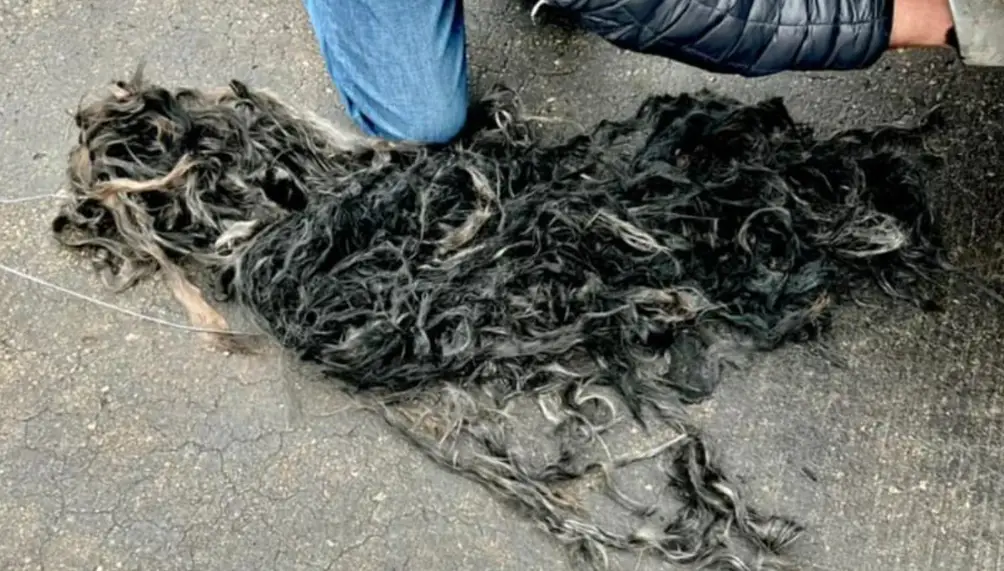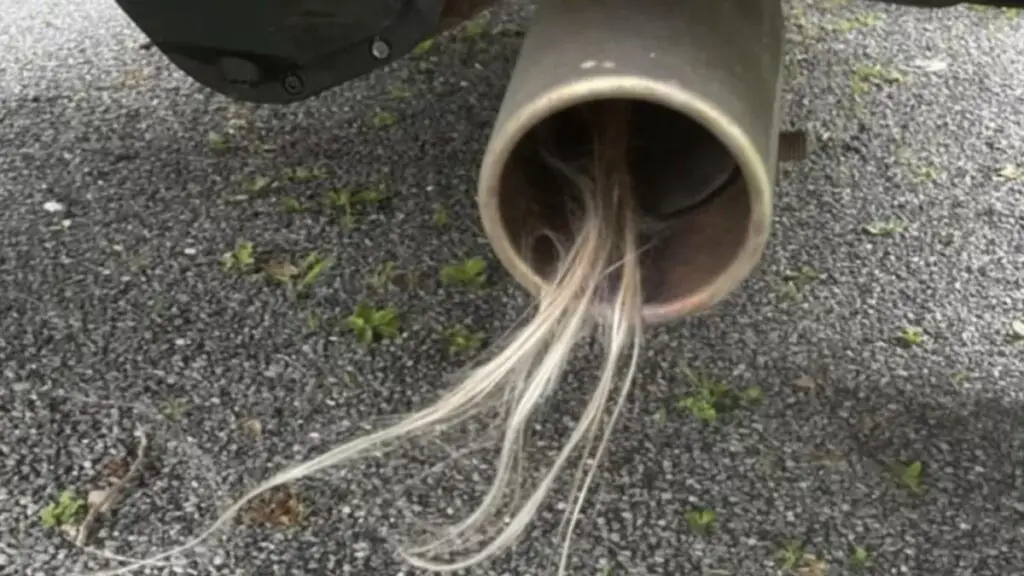Hair coming out of exhaust pipe is usually fiberglass insulation from inside the muffler or resonator. It can look like hair but is actually heat-resistant material breaking loose. This isn’t dangerous but may indicate internal exhaust wear.
Imagine checking your vehicle in the morning and seeing strands of hair poking out of your tailpipe. No, it’s not an elaborate prank or a sign your car’s haunted — what you’re witnessing is often called “muffler hair” in car enthusiast circles. While the sight can be confusing or even alarming, there’s a perfectly rational (and mechanical) explanation behind it.
In this guide, we’ll explain what this strange phenomenon really is, what causes it, whether it’s dangerous, and what you should do if it happens to your vehicle.

Contents
What Is “Hair” Coming Out of an Exhaust Pipe?
As an automotive technician, I can tell you firsthand: this isn’t actual hair. What you’re seeing is fiberglass packing material — a common sound-dampening material used inside mufflers, resonators, and some aftermarket exhaust components.
Fiberglass is used because it’s heat-resistant and effectively absorbs sound waves, helping your vehicle comply with noise regulations. When this material deteriorates and escapes, it can resemble tufts of fine, white, or gray “hair.”
What Causes Muffler Hair to Appear?
Here are the main causes why fiberglass packing might be escaping from your exhaust:
1. Muffler or Resonator Failure
Most factory and aftermarket mufflers use baffles and packing materials to absorb exhaust noise. Over time, corrosion, road salt, heat cycles, and vibration can cause the internal structure to fail. Once internal baffles or mesh degrade, fiberglass can work its way to the tailpipe and be expelled.
2. Aftermarket Exhaust Systems
High-performance or budget aftermarket mufflers often use loose fiberglass packing instead of welded chambers. These are more prone to blowout under high exhaust pressure or after prolonged use.
3. Excessive Backpressure or Poor Installations
Improper exhaust setups can create excessive turbulence, backpressure, or vibration — all of which accelerate the breakdown of muffler insulation materials.
4. Exhaust System Aging
If the exhaust system is over 10 years old, even without visible rust, internal corrosion may have weakened the baffles, allowing packing to dislodge.

Is It Dangerous?
From a mechanical perspective, it’s not immediately hazardous — but it is a warning sign. Here’s why:
- Noise Increase: Loss of internal muffler packing reduces sound suppression. You’ll likely notice a deeper or louder exhaust tone.
- Muffler Inefficiency: With insulation gone, your muffler’s performance drops, potentially affecting engine scavenging in performance-tuned setups.
- Emission Issues: In some areas, a compromised muffler can lead to inspection failures or increased emissions.
- Potential Blockage: Rarely, dislodged fiberglass may clog part of the exhaust flow (usually more of a concern in small engines like motorcycles).
⚠️ Warning: Fiberglass is a respiratory irritant. Never pull it out barehanded or blow compressed air on it. Always use gloves, eye protection, and a mask.
What Should You Do If You See “Hair” in the Exhaust?
If you spot hair-like strands in the tailpipe, follow these steps:
1. Visually Inspect the Muffler and Resonator
Check for rust holes, black soot around joints, or rattling sounds when you tap the muffler — all signs of internal damage.
2. Listen to Your Exhaust Note
A sudden change in tone often signals packing material loss. If your car sounds “raspier,” it’s time to take a closer look.
3. Avoid Touching the Material
Don’t yank the material out by hand. As mentioned, fiberglass fibers can irritate skin and lungs.
4. Visit a Muffler Shop or Mechanic
An experienced technician can inspect and confirm whether your muffler needs replacement or if it’s just a cosmetic issue.
Preventing Muffler Hair in the Future
Here are some practical tips to prevent muffler hair in the future:
- ✅ Use Quality Exhaust Components: Reputable brands like MagnaFlow, Borla, and Flowmaster use better packing materials and construction.
- ✅ Check Exhaust Hangars and Mounts: Loose components can create vibration that damages the internal structure of mufflers.
- ✅ Avoid Short Trips in Cold Weather: Moisture buildup in the exhaust promotes internal rust.
- ✅ Inspect Annually: During oil changes or inspections, have your technician tap-check the muffler and resonator.
Expert Tip
💡 If you’re running a performance exhaust with repackable mufflers (like many dirt bikes or racing setups), the presence of “muffler hair” means it’s time to repack — usually every 20–30 hours of runtime depending on the setup.
Frequently Asked Questions
Here are some FAQs on hair coming out of exhaust pipe –
1. Is the hair-like material from the exhaust dangerous to my health?
Yes — if handled improperly. It’s fiberglass, which can irritate your skin and lungs. Always wear gloves and a mask when dealing with it.
2. Do I need to replace the muffler if I see muffler hair?
In most cases, yes. Once the internal packing is compromised, the muffler will no longer effectively suppress noise or perform as designed.
3. Can I just pull the fiberglass out and keep driving?
It’s not recommended. Pulling it may dislodge more material or leave sharp fibers exposed. Plus, the problem will likely worsen with time.
4. How much does it cost to replace a muffler with muffler hair?
Expect to pay anywhere from $150 to $400 for parts and labor for a standard muffler replacement. Performance systems may cost more.
5. Can this affect my emissions test or inspection?
Yes. In some jurisdictions, a failing muffler (especially one making excess noise) can cause your car to fail inspection.
Final Thoughts
Seeing what looks like hair coming out of your exhaust can be surprising, but it’s a well-known phenomenon in the automotive world. It’s not supernatural — it’s just science and wear-and-tear. That “muffler hair” is your vehicle’s way of telling you it’s time for a check-up.
If you act quickly, you can prevent more costly repairs, stay compliant with vehicle noise regulations, and ensure your ride keeps running smoothly and quietly.